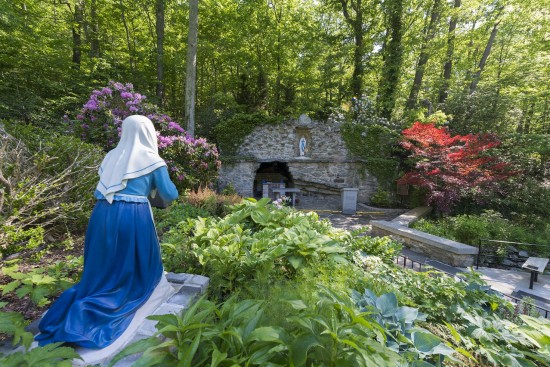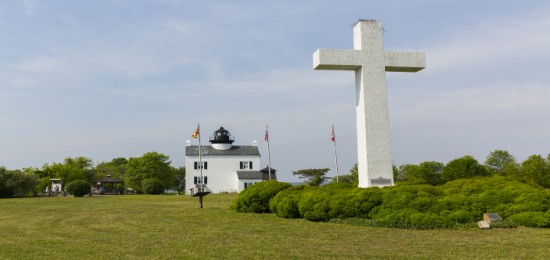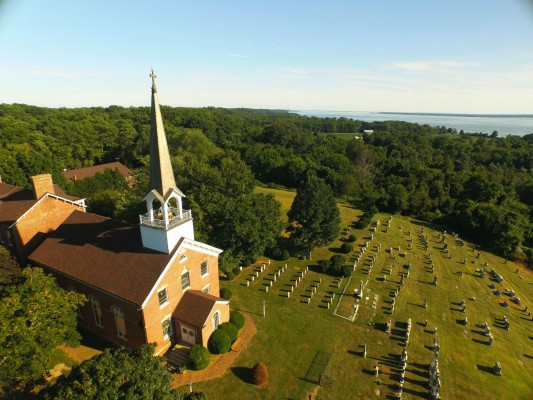Editor's Note: Maryland, the birthplace of religious freedom in America, is shining a spotlight on its religious heritage as the Papal visit approaches. Learn more about some of our nation's earliest Catholic sites and consider visiting them with your family! --Barb
Maryland is considered the birthplace of religious freedom in America, dating back to its earliest colonial days when the state became a refuge for Catholics sailing from England. As visitors flock to Washington, D.C. next week for Pope Francis’ first visit to the United States, they’ll find some of the nation’s earliest Catholic sites just next door.
The Religious Freedom Byway runs 189 miles along the Potomac River through Southern Maryland, from Port Tobacco to Point Lookout. The byway traveler will discover America’s roots of “religious tolerance” amid some of the nation’s oldest churches, located across a peaceful landscape that incorporates the early settlement of Historic St. Mary’s City.
St. Clements Island
- On March 25, 1634, the first English settlers in Maryland arrived on St. Clements Island via the Ark and the Dove to celebrate the first Catholic service. Fr. Andrew White, who then founded St. Ignatius Church, led the service. Today, St. Clements Island is a state park—accessible by boat—which is home to a memorial cross dedicated to the memory of the first Marylanders.
St. Ignatius Church
- Founded in 1641 and located in Charles County, Ignatius is one of the oldest Catholic Parishes in continuous service in the United States. Fr. Andrew White and other Jesuits sailed on the Ark and the Dove to help found an English Colony, permitting freedom of religion. The two ships arrived at St. Clements Island in March 1634. Fr. White celebrated the first Mass in Maryland and set about establishing the Catholic Church in this new land.
- White witnessed a miracle in Maryland, credited to the “relic of the True Cross,” which he carried around his neck from England to America. Fr. White was called to attend a Native American who had been impaled by the limb of a tree. The branch had gone through the upper part of his body and he was near death. Fr. White baptized him and administered the last Sacraments. Leaving instructions that, upon death, the body was to be kept for burial with the Church’s ritual, he blessed the man with the relic of the True Cross and departed. The next day, Fr. White returned to bury him and was astonished to find that he had recovered. Two small marks were all that was left of the wounds. The same relic of the True Cross, which Fr. White brought to America, remains at the Church.
St. Mary’s City
- Historic Mary's City is a museum on the site of Maryland’s first capital. Decades of research are the foundation of living history exhibits assembled across the landscape. Visitors have the opportunity to visit the first Catholic Church in the English colonies, reconstructed on its original foundation.
- A wooden chapel was first built in 1634 on this land, but was burned in 1645 after an attack on the city by forces hostile to Lord Baltimore. A new Catholic chapel was built in 1667 when the Calvert family again took charge of Maryland. This “Brick Chapel” served as the focal point of the Catholic faith in Maryland until 1704, when the royal governor ordered the building locked and never used again for religious purposes. The Jesuits dismantled the building, using its bricks to construct a new manor house for another mission. The land was sold and turned into agricultural fields in 1753. But local lore kept the location alive—and in 1938, historian H. Chandlee Froman tested the site and found that the chapel’s floor plan was in the shape of a Latin cross. The foundation was again reburied until the museum acquired the property in 1981. Archaeologists had the opportunity to excavate before the Historic St. Mary’s City Foundation began the Chapel Campaign to rebuild the church in 1997. The structure was finished and unveiled in 2009.
Basilica of the National Shrine of the Assumption of the Virgin Mary
- The historic Baltimore Basilica, built from 1806-1821, was the first great metropolitan cathedral constructed in the United States after the adoption of the Constitution. America’s First Cathedral, officially known as the Basilica of the National Shrine of the Assumption of the Blessed Virgin Mary, quickly became a symbol of the country’s newfound religious freedom. Situated on a hill above Baltimore Harbor, the historic Basilica was the center of the country’s first archdiocese, from which two-thirds of U.S. Catholic dioceses can trace their heritage.
National Shrine of Saint Elizabeth Ann Seton
- 2015 marks the 40th canonization anniversary of Saint Elizabeth Ann Seton, the first native-born saint in the U.S. Visitors can stop by the National Shrine of Saint Elizabeth Ann Seton in Emmitsburg, where she lived from 1809 until her death in 1821. A Basilica houses her tomb and the grounds offer a glimpse of the place she lived: the "white house" built for her in 1815, as well as an older "stone house" built around 1750.
 National Shrine Grotto of Our Lady of Lourdes. Photo courtesy of the Maryland Office of Tourism. All rights reserved.
National Shrine Grotto of Our Lady of Lourdes. Photo courtesy of the Maryland Office of Tourism. All rights reserved.
National Shrine Grotto of Our Lady of Lourdes
- Emmitsburg's beautiful mountain National Shrine Grotto of Our Lady of Lourdes features one of the oldest American replicas of the Lourdes shrine in France. Built about two decades after the apparition of Mary at Lourdes in 1858, it attracts hundreds of thousands of pilgrims each year from all over the world.
Maryland is home to many of the oldest religious sites in America, and these are just a few. Traveling a short distance from Washington, D.C. brings you closer to the history of the Catholic Church within our country. As the papal visit nears, consider those people who sacrificed so much to practice their religion freely in the new world. Visit these locations and grow closer to your faith.
About the author: Leslie Troy is a Communications Specialist with the Maryland Office of Tourism.
Copyright 2015 Leslie Troy
Photos courtesy of the Maryland Office of Tourism. All rights reserved.
About the Author

Guest
We welcome guest contributors who graciously volunteer their writing for our readers. Please support our guest writers by visiting their sites, purchasing their work, and leaving comments to thank them for sharing their gifts here on CatholicMom.com. To inquire about serving as a guest contributor, contact editor@CatholicMom.com.




.png?width=1806&height=731&name=CatholicMom_hcfm_logo1_pos_871c_2728c%20(002).png)
Comments